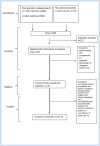Risk factors of catheter- associated bloodstream infection: Systematic review and meta-analysis
- PMID: 36952393
- PMCID: PMC10035840
- DOI: 10.1371/journal.pone.0282290
Risk factors of catheter- associated bloodstream infection: Systematic review and meta-analysis
Abstract
Introduction: The prevalence of catheter-associated bloodstream infections (CLABSI) is high and is a severe health problem associated with an increase in mortality and elevated economic costs. There are discrepancies related to the risk factors of CLABSI since the results published are very heterogeneous and there is no synthesis in the description of all the predisposing factors.
Objective: We aimed to perform a systematic review and meta-analysis to synthesize and establish the risk factors predisposing to CLABSI reported in the literature.
Method: This is a systematic review of observational studies following the PRISMA recommendations. MEDLINE and CINAHL databases were searched for primary studies from 2007 to 2021. The protocol was registered in PROSPERO CRD42018083564.
Results: A total of 654 studies were identified, 23 of which were included in this systematic review. The meta-analysis included 17 studies and 9 risk factors were analyzed (total parenteral nutrition (TPN), chemotherapy, monolumen and bilumen catheters, days of catheterization, immunosuppression, kidney disease and diabetes mellitus) due to the homogeneity of their definitions and measurements. The risk factors found to increase the probability of developing CLABSI were TPN, multilumen devices, chemotherapy treatment, immunosuppression and the number of days of catheterization. On the other hand, monolumen devices presented a lower likelihood of triggering this infection.
Copyright: © 2023 Lafuente Cabrero et al. This is an open access article distributed under the terms of the Creative Commons Attribution License, which permits unrestricted use, distribution, and reproduction in any medium, provided the original author and source are credited.
Conflict of interest statement
The authors have no conflict of interest.
Figures










References
-
- Sociedad Española de Medicina Preventiva, Salud Pública Higiene [Sede Web]. Estudio de Prevalencia de las infecciones Nosocomiales en España. EPINE-EPPS 2017 [Acceso: 1/1/ 2020]; Disponible en: http://hws.vhebron.net/epine/Global/EPINE%20EPPS%202017%20Informe%20Glob...
-
- Climo M, Diekema D, Warren DK, Herwaldt LA, Perl TM, Peterson L, et al.. Prevalence of the use of central venous access devices within and outside of the intensive care unit: results of a survey among hospitals in the prevention epicenter program of the Centers for Disease Control and Prevention. Infect Control Hosp Epidemiol. 2003. Dec;24(12):942–5. doi: 10.1086/502163 - DOI - PubMed
-
- Chaves F, Garnacho-Montero J, Del Pozo JL, Bouza E, Capdevila JA, de Cueto M, et al.. Diagnosis and treatment of catheter-related bloodstream infection: Clinical guidelines of the Spanish Society of Infectious Diseases and Clinical Microbiology and (SEIMC) and the Spanish Society of Spanish Society of Intensive and Critical Care Medicine. Med intensiva. 2018;42(1):5–36. - PubMed
-
- Buetti N, Marschall J, Drees M, Fakih MG, Hadaway L, Maragakis LL, et al.. Strategies to prevent central line-associated bloodstream infections in acute-care hospitals: 2022 Update. Infect Control Hosp Epidemiol [Internet]. 2022. May 19 [cited 2022 Oct 28];43(5):553–69. Available from: https://pubmed.ncbi.nlm.nih.gov/35437133/ doi: 10.1017/ice.2022.87 - DOI - PMC - PubMed

